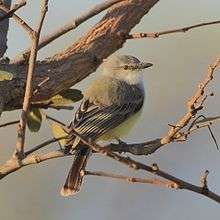Suiriri flycatcher
The suiriri flycatcher (Suiriri suiriri) is a species of bird in the family Tyrannidae found in semi-open habitats in South America. It was formerly split into two species; the Chaco suiriri (S. suiriri) and the Campo suiriri (S. affinis). Suiriri originates from Guaraní, where it is a generic name used for several medium-sized tyrant flycatchers.[2]
| Suiriri flycatcher | |
|---|---|
 | |
| at Boa Esperança do Sul, São Paulo State, Brazil | |
| Scientific classification | |
| Kingdom: | Animalia |
| Phylum: | Chordata |
| Class: | Aves |
| Order: | Passeriformes |
| Family: | Tyrannidae |
| Genus: | Suiriri d'Orbigny, 1840 |
| Species: | S. suiriri |
| Binomial name | |
| Suiriri suiriri (Vieillot, 1818) | |
Taxonomy
The suiriri flycatcher was described by the French ornithologist Louis Vieillot in 1818 under the binomial name Muscicapa suiriri.[3] The type locality is Puerto Pinasco in Paraguay.[4] It has traditionally been split into two species, the southern Chaco suiriri (S. suiriri) with a white belly and the northern Campo suiriri (S. affinis) with a yellow belly and a contrastingly pale rump, but they interbreed widely where they come into contact, and consequently most authorities now consider them to be part of a single species. It has been suggested that the taxon bahiae from north-eastern Brazil, which is considered a subspecies of S. affinis when that species is split from S. suiriri, actually is the result of hybridization between suiriri and affinis. For the most part it resembles the latter, but it lacks a contrastingly pale rump as the former.
The chapada flycatcher is a cryptic species that was included within the suiriri flycatcher until it was described in 2001. While both these species are relatively noisy, only the chapada flycatcher has the distinctive wing-lifting display.
Three subspecies are recognised:[5]
- S. s. burmeisteri Kirwan, Steinheimer, Raposo & Zimmer, KJ, 2014 – south Suriname, central Brazil and northwest Bolivia
- S. s. bahiae (von Berlepsch, 1893) – east Brazil
- S. s. suiriri (Vieillot, 1818) – east Bolivia, southwest Brazil, Paraguay, Uruguay and north Argentina
Distribution and habitat
The suiriri flycatcher occurs in a wide range of semi-open habitats such as Chaco, Caatinga and Cerrado, but generally avoids humid habitats such as the Amazon Rainforest. It ranges from northern Argentina, through Uruguay, Paraguay, eastern Bolivia, to a large part of eastern Brazil, with disjunct populations in southern Guyana, Amapá, and near the lower section of the Amazon River and central Madeira River. These disjunct populations are associated with remnant patches of relatively dry woodland and savanna that largely – or entirely – are surrounded by humid Amazonian forests.
It is fairly common locally, and consequently considered to be of least concern by BirdLife International.[1]
References
- BirdLife International (2012). "Suiriri suiriri". IUCN Red List of Threatened Species. 2012. Retrieved 26 November 2013.CS1 maint: ref=harv (link)
- "Suiriri Flycatcher". Faunaparaguay.com. Retrieved 2 February 2009.
- Vieillot, Louis Jean Pierre (1818). Nouveau dictionnaire d'histoire naturelle, appliquée aux arts, à l'agriculture, à l'économie rurale et domestique, à la médecine, etc (in French). Volume 21. Paris: Deterville. p. 487.
- Traylor, Melvin A. Jr, ed. (1979). Check-list of Birds of the World. Volume 8. Cambridge, Massachusetts: Museum of Comparative Zoology. p. 20.
- Gill, Frank; Donsker, David, eds. (2019). "Tyrant flycatchers". World Bird List Version 9.2. International Ornithologists' Union. Retrieved 26 June 2019.
Further reading
- Kirwan, G.M.; Steinheimer, F.D.; Raposo, M.A.; Zimmer, K.J. (2014). "Nomenclatural corrections, neotype designation and new subspecies description in the genus Suiriri (Aves: Passeriformes: Tyrannidae)". Zootaxa (3784): 224–240. doi:10.11646/zootaxa.3784.3.2.
- Lopes, L.E.; Chaves, A.V.; Mendes de Aquino, M.; Silveira, L.F.; dos Santos, F.R. (2017). "The striking polyphyly of Suiriri: convergent evolution and social mimicry in two cryptic Neotropical birds". Journal of Zoological Systematics and Evolutionary Research. 56 (2): 270–279. doi:10.1111/jzs.12200.
- Zimmer, K.J.; Whittaker, A.; Oren, D.C. (2001). "A cryptic new species of flycatcher (Tyrannidae: Suiriri) from the Cerrado Region of Central South America" (PDF). The Auk. 118 (1): 56–78. JSTOR 4089758.</ref>
External links
| Wikimedia Commons has media related to Suiriri suiriri. |
| Wikispecies has information related to Suiriri suiriri |
- BirdLife species factsheet for Suiriri suiriri
- "Suiriri flycatcher media". Internet Bird Collection.
- Suiriri flycatcher photo gallery at VIREO (Drexel University)
- Suiriri flycatcher species account at Neotropical Birds (Cornell Lab of Ornithology)
- "Suiriri [suiriri or affinis]". Avibase.

- Interactive range map of Suiriri suiriri at IUCN Red List maps
- Audio recordings of Suiriri flycatcher on Xeno-canto.
